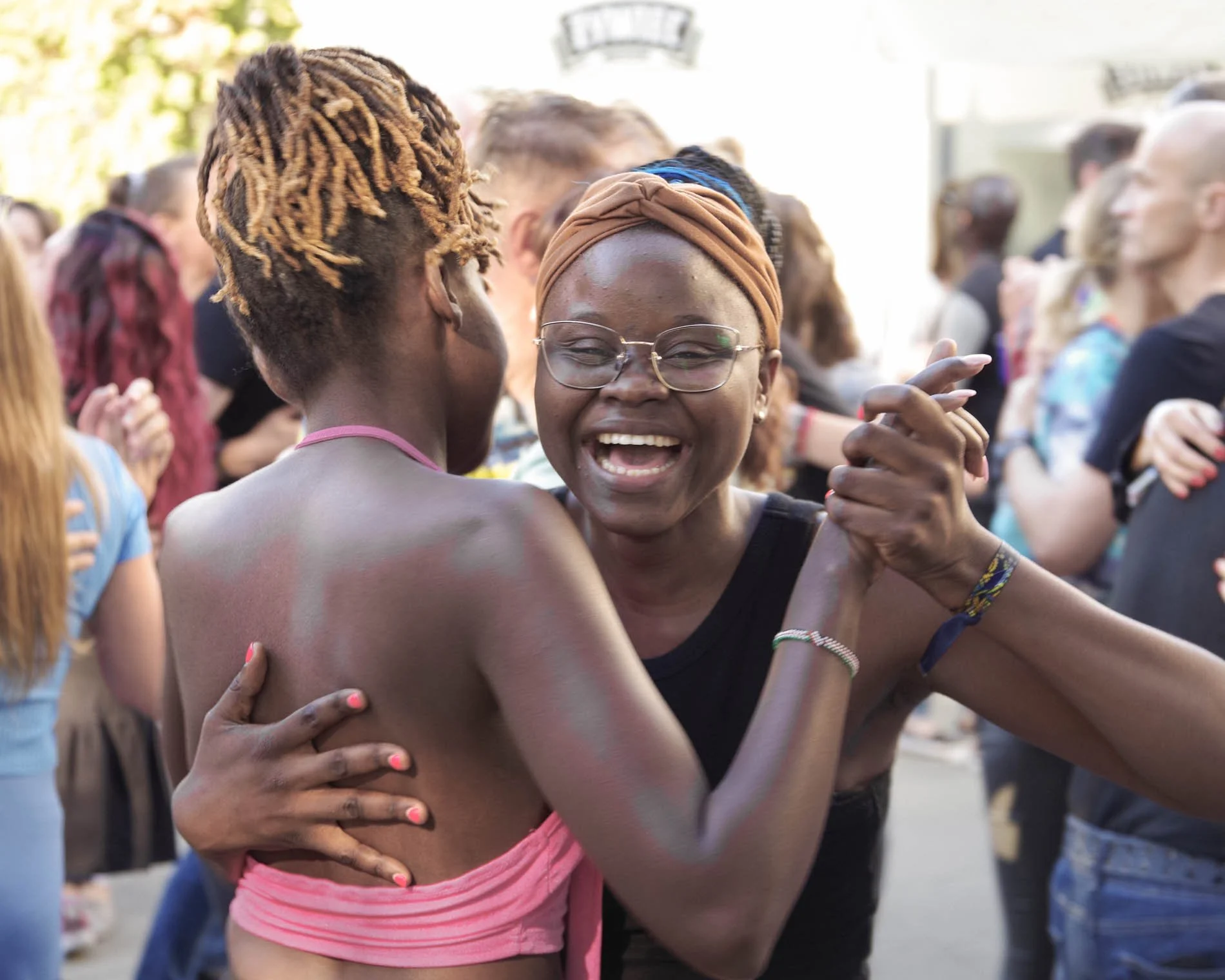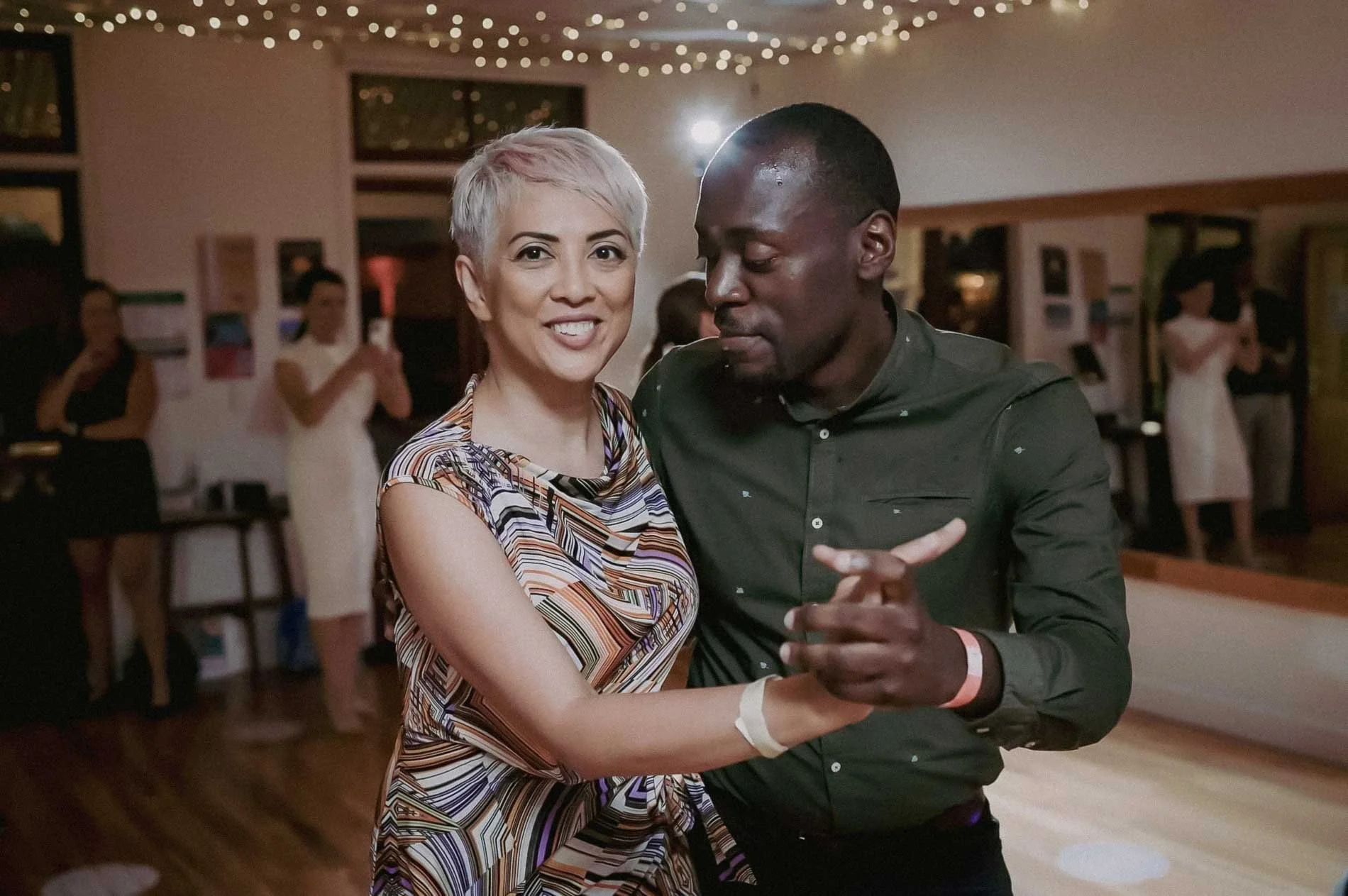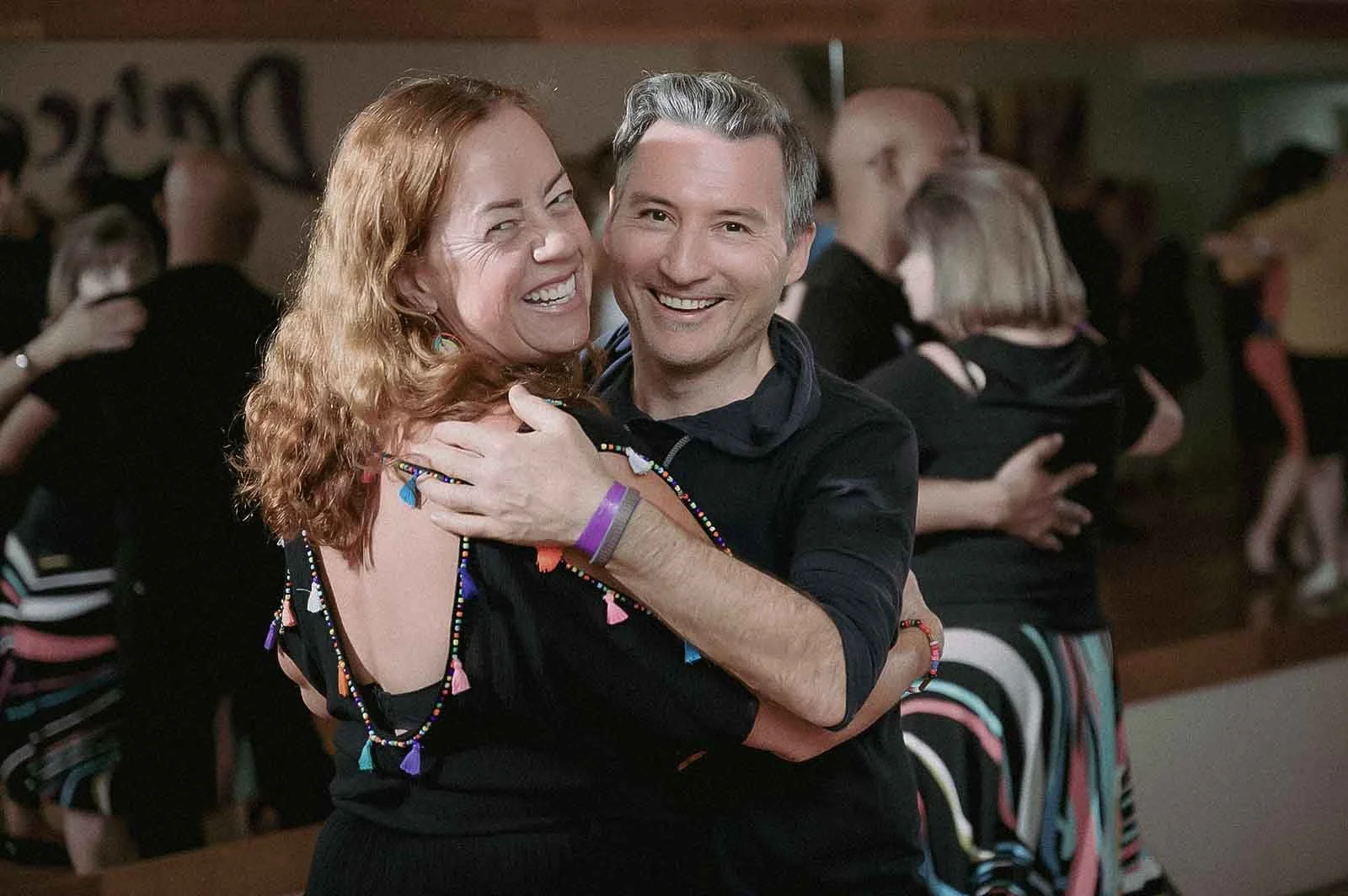To dance is an expression of freedom
TARCISIO TIATINI-CLIMACO
Dance Kizomba in Brisbane
Curious about learning to dance in Brisbane?
Looking for a fun, social hobby that keeps you moving and connected?
Kizomba in Brisbane is growing — and you’re invited to be part of it. This beautiful partner dance has roots in Angola and a global following today. It’s smooth, soulful, and deeply social — perfect for anyone wanting to try something new, meet great people, and enjoy music in a whole new way.
No partner or experience needed. Our beginner-friendly Kizomba classes in Brisbane are open to everyone, and you’ll be warmly guided through the basics of connection, rhythm, and movement in a relaxed, welcoming space.
Whether you come solo or with a friend, you’ll discover not just a dance style, but a whole community ready to greet you on the floor. Dancing is good for your body, your mood, and yes — even your lifespan. So why not give it a go? The music is calling.
-

4 Week Kizomba Beginners and Fundamentals
Ever wanted to try dancing but weren’t sure where to start? You don’t need a partner or any experience — just a little curiosity and a willingness to try something new.
Kizomba is a soulful partner dance from Angola, known for its rhythm, connection, and sense of community.
In this beginner course, you’ll build confidence, boost your dance fitness, and discover a style that’s both joyful and grounding — all in a warm, welcoming space.
$120
-

Intermediate Group Classes
Tuesdays 6:45-7:45pm
Kizomba is always evolving, with new layers of movement and feeling emerging all the time — even the basics keep shifting! In this intermediate class, you’ll explore musicality, flow, and connection while building confidence, presence, and stronger ties with your dance community.
Bundle up & save with a 4 week pass or pay casually on the night via transfer, card or cash.
4 week pass ~ $100
Casual drop in ~ $30 -

Private Lessons
Want to level up your Kizomba? Prefer learning one-on-one, at your own pace? Or need revisit something from class that didn’t quite click the first time?
Private lessons give space to focus on your needs — whether it’s footwork, connection, musicality, or just getting that one move to feel right. They’re a great way to build confidence, helping you bring best your self onto the social dance floor no matter where you’re at in your dance journey.
1 to 5 lesson packs ~ from $90 per lesson
Minimum 3 month weekly privates ~ $85 per lesson -

International Artists
Over the years, we’ve had the pleasure of welcoming international Kizomba artists to Brisbane from Angola, Finland, Portugal, and Guinea-Bissau. Artists like Camba & Anna Maria, Eddy Vents, and Adilson & Telma — each bringing their own flavour, cultural depth, and passion for Kizomba and Semba.
In July 2025, we hosted Kirsi VanSol and Dasmara Dossantos. Kirsi brings Kizomba straight from the source, working closely with top Angolan artists and training students who’ve gone on to teach around the world. Angolan born Dasmara, known for his creativity, elegance and technical skill, is an inspiration to dancers across Europe and beyond.
In the Angolan Kimbundu language, Kizomba means “party”. Kizomba embraces a culture of coming together and sharing food, music and dance.
We, and others in the Kizomba community, regularly run parties where you can connect with people from your classes as well as the wider community.
Come join us. Make new friends. Build beautiful connections.
Testimonials
About our classes
-
Absolutely! You don’t need any dance experience to start learning Kizomba. Everyone begins somewhere and this beginner series is exactly where you’ll learn the fundamentals, step by step.
In many cultures, dancing is just part of life. You grow up swaying to music at family gatherings, moving with others, no formal training needed. In the West, we sometimes lose that natural connection, but it’s still an innate part of you. You can dance. You just need a space that’s welcoming, safe, and fun enough to let it come out.
So bring your two left feet (we’ll sort them out), and come discover how good it feels to move with rhythm, connection, and confidence.
-
No partner? No problem! You don’t need to sign up with someone — lots of people come solo. In class, we rotate partners regularly so everyone gets a chance to dance, connect, and learn from each other as part of learning is that its a social community dance.
Rotating is one of the best ways to build your skills, it teaches you how to adapt to different partners, which helps you become a more confident and versatile dancer.
If you do come with a partner and prefer to stay together, that’s totally fine too, just let us know at the start. The vibe is relaxed, welcoming, and all about learning in a way that feels comfortable for you.
-
Kizomba is a somewhat close dance style, and that closeness is part of what makes it feel so connected and fluid because we share an axis. You’ll sometimes be in chest-to-chest, sometimes apart, this is a dynamic fun and joyful dance.
But connection isn’t only about touch, it’s also built through the music, trust, respect, and the shared rhythm. If you’re new to this kind of dance, it might feel unfamiliar at first, and that’s totally normal. You’ll be supported to explore the connection at your own pace, and your comfort always matters.
-
By the end of the 4-week beginner course, you’ll have everything you need to start enjoying Kizomba on the social dance floor. You’ll know the essential steps, understand how to connect with a partner, and feel the rhythm enough to dance with confidence, even if you're still finding your flow.
From there, some dancers move into the intermediate class, while others prefer to repeat the beginner course, take a few private lessons, or get in extra practice at socials. There’s no one right path, it all depends on what helps you feel most comfortable and confident.
Whichever direction you choose, you’ll be equipped with the skills to start dancing, connecting, and feeling right at home on the social floor.
-
The intermediate class is designed for dancers who already feel confident with the basics, things like walking in connection, leading or following fundamental steps, and keeping time with the music.
There’s no exact number of classes that makes you “ready”. It’s more about the muscle memory you have in your body. If you can relax into the rhythm, stay connected with your partner, and respond to changes in the music without overthinking, you’re probably ready to start exploring more complexity and musicality.
If you’re not sure if you’re ready to level up, just ask. There’s no rush. The goal is to feel solid and supported so you can enjoy the learning journey at every stage.
-
Life happens, we get it!
For a beginner course, since it’s a four-week series, if you miss a class, unfortunately, we can’t offer a make-up for that particular session. Each week builds on the last, so we encourage you to attend as consistently as you can.
For Intermediate classes, we offer a bit more flexibility. The 4-class pass is valid for 7 weeks and is designed to support consistent learning and progression. To help keep the class running smoothly, it’s really helpful if you let me know in advance if you’ll be away.
While the pass is valid for 7 weeks, we encourage regular attendance so everyone can grow and progress together.
Special circumstances can be accommodated, just reach out.
And remember, if you ever want extra help catching up, private lessons or social dance practice are great ways to fill in the gaps!
-
There’s no dress code, just wear something comfy that you can move in. In class most people dance in socks, or in smooth-soled flat shoes that let you move easily across the floor. Runners with grippy soles can make things a bit awkward, so they’re best avoided.
Some dancers like to bring a towel or a change of shirt (hello, Brisbane humidity!) and a water bottle is always a good idea. Most importantly? Just bring yourself, an open mind, and a willingness to try something new.
-
Outside of class, there are plenty of opportunities to dance, connect, and grow your confidence on the social floor — and Brisbane has a warm, welcoming Kizomba community.
On the last Sunday of every month, we host Kizomba na Rua in Fish Lane, an outdoor, alfresco social inspired by a beautiful tradition from Angola, the homeland of Kizomba. In Angola, this street party happens every Sunday, and while we only do it monthly, we’re proud to be the only Kizomba community in Australia bringing this tradition to life!
Let’s not forget our long-running tradition of Kizomba Soirée at Lychee Lounge, a cosy, vibey night of dancing, good company, and great cocktails. You’ll also find a few Kizomba da Bwé parties throughout the month. Whether you’re dancing under the stars or in a dimly lit lounge with friends, socials are where it all starts to come together. Keep an eye out on (Facebook LINK here) for all the upcoming events.
From time to time, there may also be workshops to help you dive deeper into technique or try something new. And keep an eye out for Weekenders, special events where we bring top international teachers, including some from Angola, to Brisbane. They come to share their skills, culture, and joy… and of course, party with us. It’s an amazing way to level up your dancing and feel part of the global Kizomba family.
About Kizomba
-
Kizomba stands out for its deep cultural roots and community spirit. Kizomba is a family dance! You can dance Kizomba with your mum or grandpa, with you children and your friends. Kizomba makes everyone feel better!
Kizomba, in both its music and dance, is often seen as the “daughter” of Semba, sharing the same cultural roots.
In Angolan culture, music and dance have always been part of everyday life, woven into gatherings of family, friends, and community.
Kizomba continues this tradition, offering a space where people connect through music, dance, hugs and community. Kizomba is about caring for each other.
-
Great question, and one that comes up a lot!
Kizomba and what’s often known as its mother, Semba, are cultural dances with deep roots in Angola. Both are African grounded partner dances that emphasise connection, rhythm, and flow, but they carry different energies. Semba is lively and playful, known for its upbeat tempo and expressive footwork and tricks. Kizomba, which evolved from Semba, brings a smoother, more relaxed feel.
In these classes, you’ll be learning movement and connection that reflect both styles, so while we call it “Kizomba” on the schedule, what you’ll experience is a strong foundation that applies to both dances, rooted in Angolan culture.
Over time, as Kizomba spread around the world, new styles began to evolve. In Europe, some dancers created a more westernised style, linear and more upright, staccato and sharp movements, and pauses. That became what's now known as UrbanKiz. For many years, it was also referred to as “Kizomba,” which is why when you type Kizomba online you often see a misrepresentation of Kizomba and are actually seeing anything ranging from UrbanKiz, Tarraxinha and Kiz Fusion!
Today, people are becoming more educated about the significant differences. UrbanKiz, Tarraxinha and Kiz Fusion are all separate dances, part of the broader “Kizomba umbrella” and all danced on different monorhythmic music instead of the rich polyrhythmic music we dance Kizomba and Semba to.
What you’ll be learning here stays close to the Angolan heart of Kizomba and Semba: soulful, cultural, and full of fun and feeling.
-
Kizomba has its own unique flavour, but if we had to draw comparisons, it shares a few elements with Argentine tango, and the waltz especially the close embrace and chest-led connection between partners. But that’s where the similarity ends. Kizomba is more relaxed, more grounded, and has a vibe that ranges from soulful to joyful, depending on the music.
If you’re coming from salsa or bachata, get ready for a different feel, and a different way of learning. Kizomba doesn’t follow a fixed 1-to-8 count in a mechanical way. Instead, it’s guided by the feeling and texture of the music, especially its rich, layered polyrhythmic rhythms.
Rather than counting each beat, Kizomba flows more naturally. We often follow what’s known as the “Rule of 3”, a rhythmical pattern that supports dynamic, circular movement every three steps or so. But more than anything, it’s about listening to the music! Some songs invite soft, close connection; others bring out a playful side and a sense of joy, creating dance poetry in motion.
In class, you’ll learn to stay balanced over your axis, attune to the rhythm, and move in connection with your partner, whether through the smooth walk (Passada), a contra tempo (Retrocesso), or turns and variations.
In short? Kizomba’s not like anything else, and that’s exactly why people fall in love with it.











